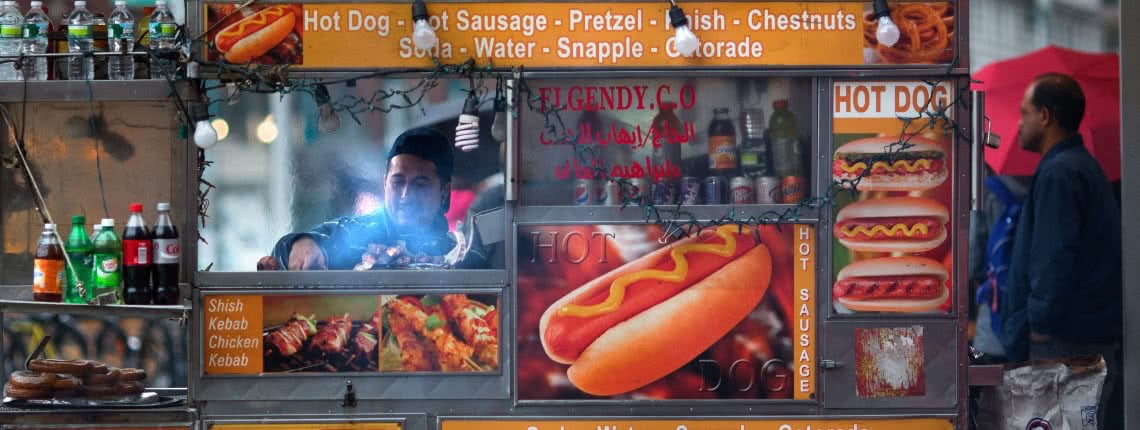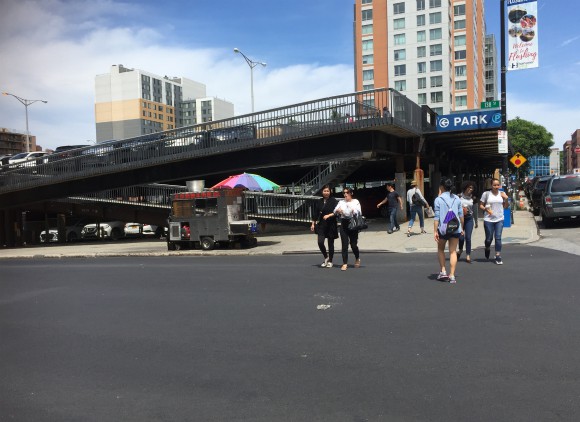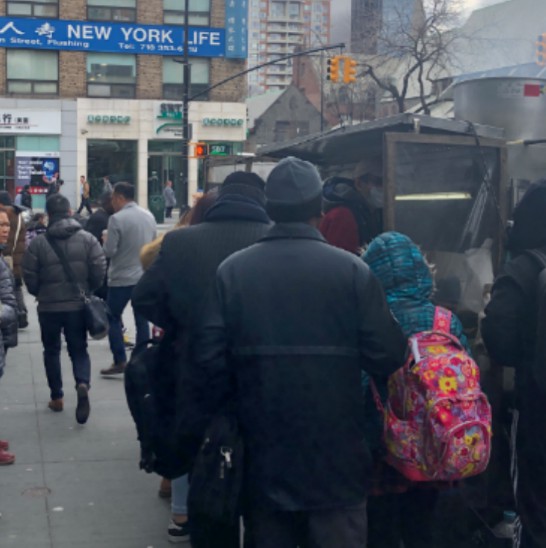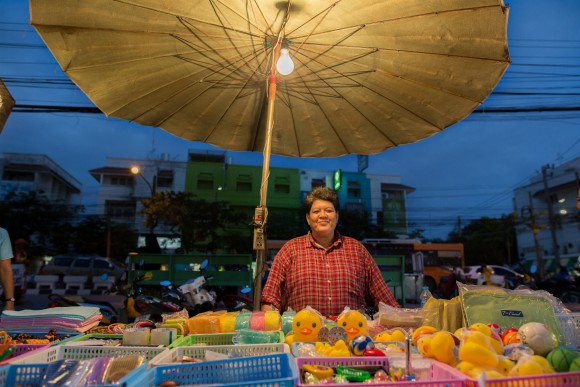
“Lin’s” BBQ cart was once a busy operation in the center of downtown Flushing, a prosperous and predominately East Asian neighborhood in Queens, New York City. People used to wait in long lines for five-to-ten minutes just for a taste of lamb or chicken skewers, fresh off her charcoal grill.
Now Lin sits with her cart on a quiet side street in the shadow of a parking garage. Instead of ten-minutes lines, ten minutes pass between single customers.
Lin’s whole life changed in 2018, when business and political elites in Flushing decided that Lin and other vendors like her were no longer welcome.

Their official argument was that vendors caused congestion, but less officially, they saw vendors as unpleasant eyesores. Their comments echoed the rhetoric of anti-vendor governments and elites around the world.
But our forthcoming research tells a different story: The majority of people who work and live in Flushing want Lin and other vendors like her to stay. Our findings are a reminder that issues around public-space access are controlled by powerful interests – a story not so different between the Global North and South, whether it’s a city like New York or Bangkok, Lima, or Lagos.
A changing Flushing
Flushing, Queens, is home to one of New York’s largest concentrations of Asian immigrants. The area is a dense mix of people from Taiwan, Hong Kong and mainland China.
The downtown shopping area is where most street vendors ply their trade. The majority of Flushing’s food vendors are Chinese immigrants selling foods that provide residents with a taste of home: grilled meat skewers, sweet egg cakes, and roasted chestnuts.
Developers and investors are working to turn Flushing into a home and destination for wealthy people with expensive tastes.
But Flushing is changing. Developers and investors are working to turn Flushing into a home and destination for wealthy people with expensive tastes, rather than the working class neighborhood it has historically been.
As part of this plan, in October 2018, a new law was passed banning all street vending in the downtown area. Opponents of vendors made two distinct kinds of arguments against vending.

The first was based on objective criteria, such as crowding. As one business leader argued in a public hearing, “…especially during lunch time, our sidewalk is very congested and I often see people walking on the street and it’s very dangerous there…because there are so many carts on the street.”
It made sense that leaders would use crowding as an excuse to ban vendors. Their rhetoric echoes the arguments made by officials in places like Bangkok, Thailand, who have similarly attacked vendors under the motto “return the footpath to pedestrians.”
Their rhetoric echoes the arguments made by officials in places like Bangkok, Thailand, who have similarly attacked vendors under the motto "return the footpath to pedestrians."
But during hearings and in the New York press, the real reason for vendor restrictions often slipped out: vendors just didn’t fit the luxury image that Flushing’s business interests are trying to create.
So, claiming to speak for the entire neighborhood, political and business elites complained that vendors sell shabby merchandise and low-quality food that “nobody” wants and that they operated “at the expense of their community”. According to one community member we spoke with, upper-class residents didn’t like vendors because they were “visual reminders of poverty” and didn’t want to see them on the sidewalks.
What Flushing residents really thought about vendors
These negative claims were getting a lot of airtime, but were they true? We developed a research methodology to investigate this question. Our work draws on a study conducted by researchers in Bangkok to assess the underlying causes of sidewalk congestion in that city.

With the help of volunteers, we collected 250 surveys over three days in Flushing. We targeted three groups: vendor customers, people hanging out in public space, and commuters. The people we surveyed were an accurate representation of the neighbourhood: about 70% of respondents were from Flushing; 71% were immigrants; and nearly half of all respondents were born in China.
So did the views of average people in Flushing conform to those statements being made on their behalf by real estate tycoons and their allies in city government? The short answer is no.
Vendors were blamed for crowding by proponents of the ban. While 84% of people agreed that Flushing was crowded, they did not name vendors as a major cause of crowding. Of 10 reasons for crowding in Flushing, street vendors ranked 7th, just after “people passing out flyers”. This resonates with findings from Bangkok.
The majority of commuters and public-space users (56%) wanted vendors to stay; this number increases to 70% when including street food consumers, as well.
To justify the ban, anti-vending advocates argued that nobody likes vendors and that the community wanted them gone. According to our research, this is not the case. The majority of commuters and public-space users (55%) wanted vendors to stay; this number increases to 70% when including street food consumers, as well.
When asked why, respondents said things like, “people rely on these vendors”, “vendors work hard; we should support them”, and “street vendors are some of the best parts of Flushing”. Hardly the words of a community that doesn’t think vendors belong.
In general, people with lower incomes had more favorable views about vendors, while higher-income people were more likely to perceive vendors as a problem and more likely to be in favor of the vendor ban. In comments, wealthier respondents were also more likely to see vendors as “unclean”, as selling “unhealthy” or “dirty” food, or see them as causing “security risks”.
On the other hand, many of the people who agreed with the vendor ban did identify vendors themselves as a problem. Instead, they indicated a more general malaise with Flushing: “Too many people. The neighborhood is unclean. The air is poor quality.”
In general, people with lower incomes had more favorable views about vendors.
In the end, we can say that the data shows that social class informs feelings about vendors, and class bias drives vendor exclusion, not objective planning or policy criteria. It also shows that business leaders who claim to speak for the public do not represent the public interest, but rather are advocating for their own narrow economic interests when they seek to ban vending.
Lin’s BBQ cart and the global fight for inclusive public spaces
When we spoke with Lin, the BBQ meat vendor, after the ban was enacted, she was worried about her future. Her revenue had been cut in half by her move to this new out-of-the-way location. She seemed trapped and unsure of how to move forward. She wasn’t making enough money to cover her costs and didn’t know what to do.
Experience from Bangkok to Flushing demonstrates the need to challenge “official” wisdom about vending, which is so often dominated by elites.
Before starting her vending business she held a job as a home health care aide. But she said she was too old now to help clients into beds and out of bathtubs. She couldn’t go back to dealing with low wages, long hours, and emotionally draining conditions. Street vending had been a way for her to escape exploitative wage labour, a path toward independence. Now, thanks to a law passed for the benefit of developers of luxury condos and fancy new malls, Lin’s once-successful business – her source of hope – had been taken away from her.
Experience from Bangkok to Flushing demonstrates the need to challenge “official” wisdom about vending, which is so often dominated by elites in public statements and via social media. We wager that in most places, anti-vendor rhetoric does not match the reality of public opinion. Gathering the perceptions of from ordinary people who regularly use public space pokes holes in justifications for vendor restrictions, and can help advocate for more just and inclusive public spaces for informal workers.
Sign up here to receive the forthcoming report on street vendors in Flushing, published by WIEGO, by Ryan Thomas Devlin, Visiting Professor of Urban Planning, Columbia University GSAPP, and Sarah Orleans Reed.
Download our toolkit for Supporting Informal Workers in Public Spaces.
First photo: "In his own world" by aftab is licensed under CC BY-NC 2.0.
Para leer este artículo en español, haga click aquí.
Pour lire cet article en français, cliquez ici.
Related Posts
-
Informal Economy Theme
-
Informal Economy Topic
-
Occupational group
-
Region
-
Language
